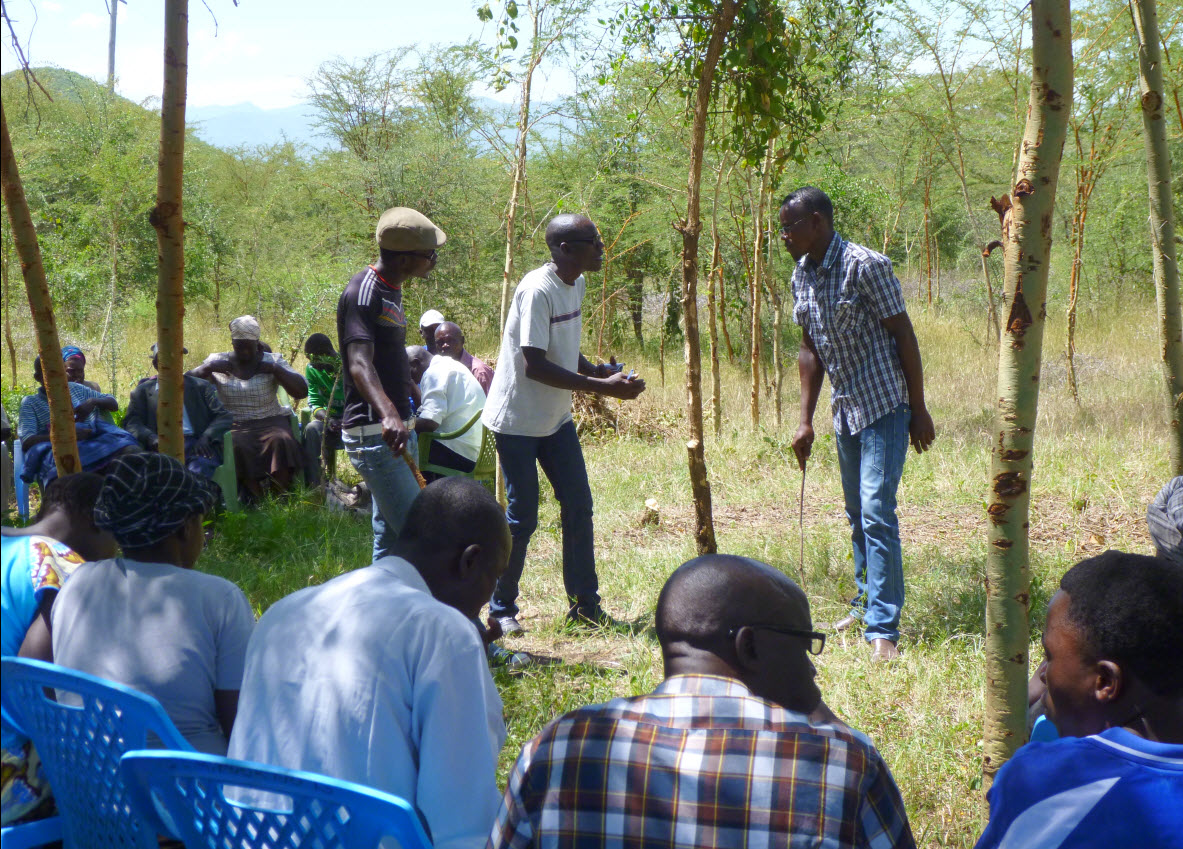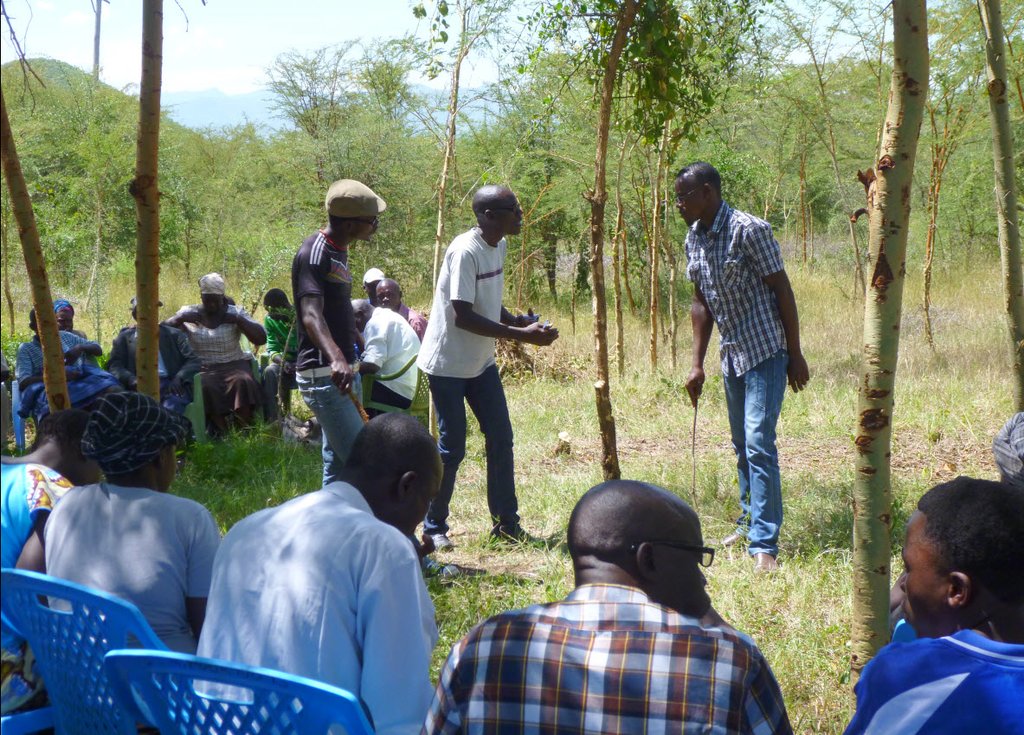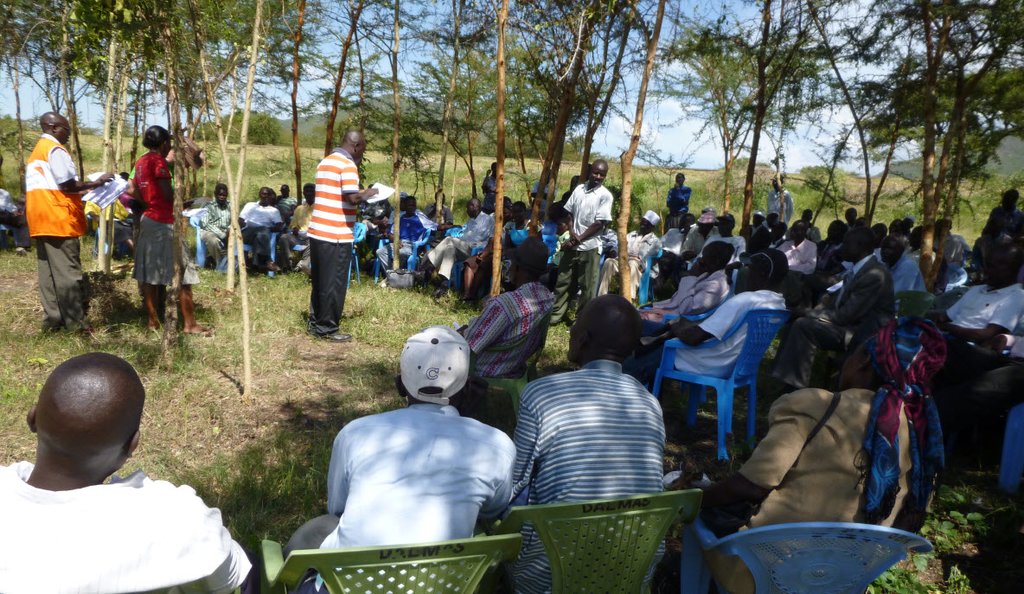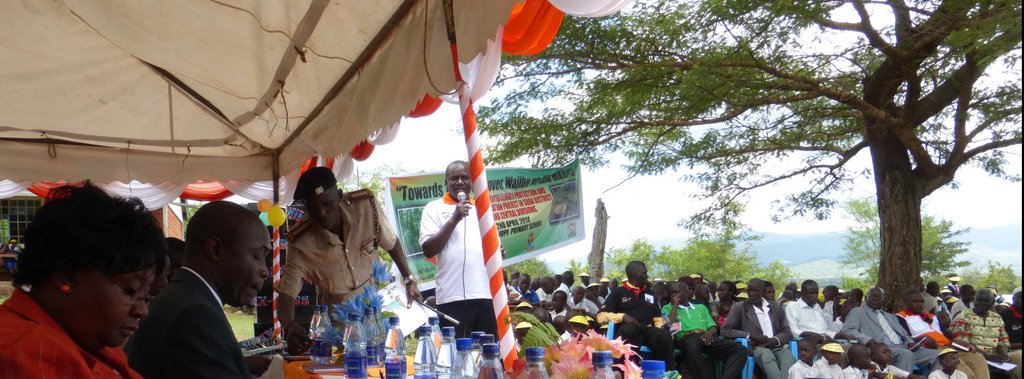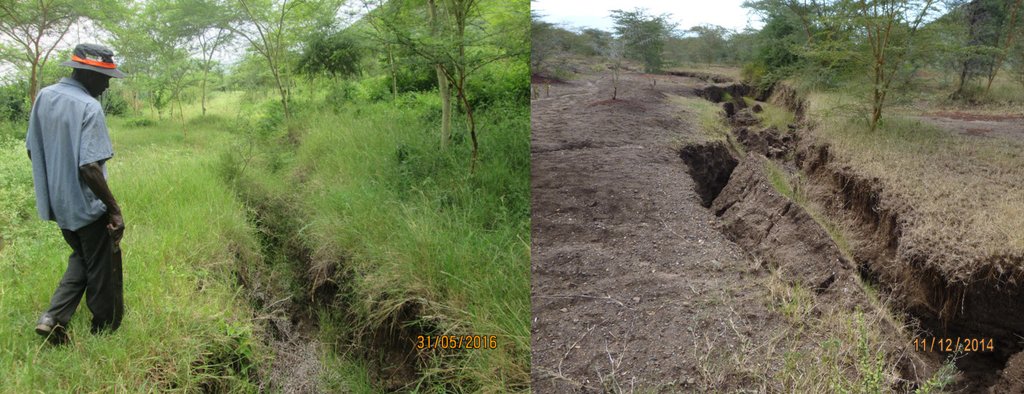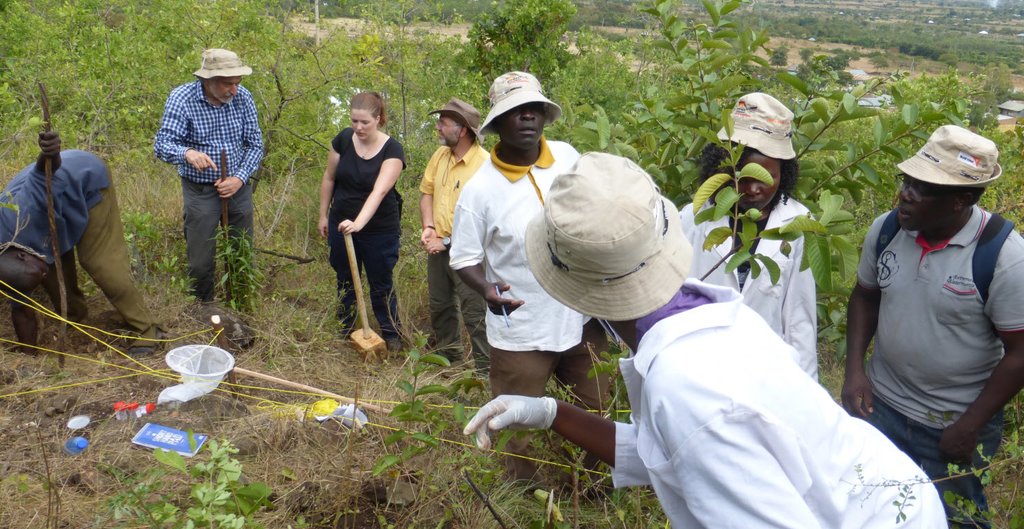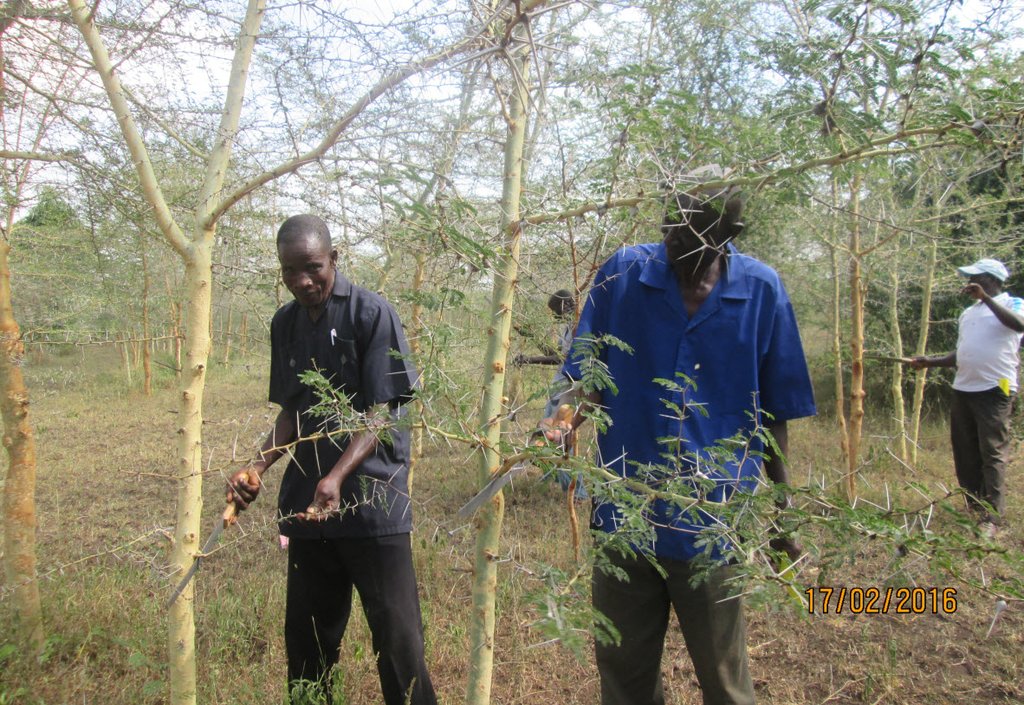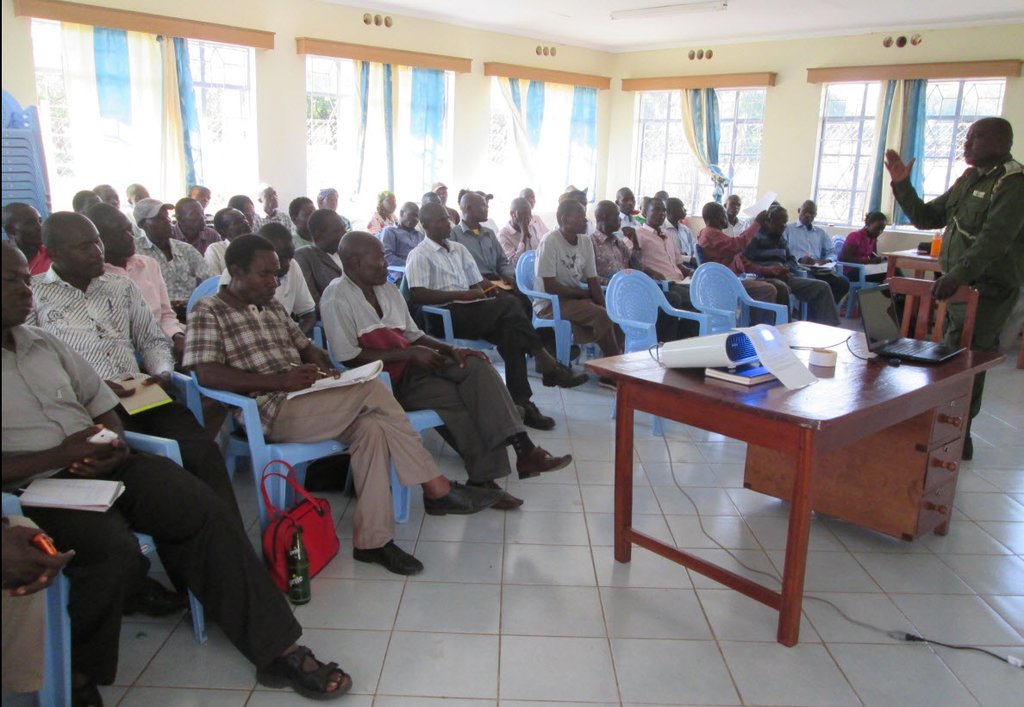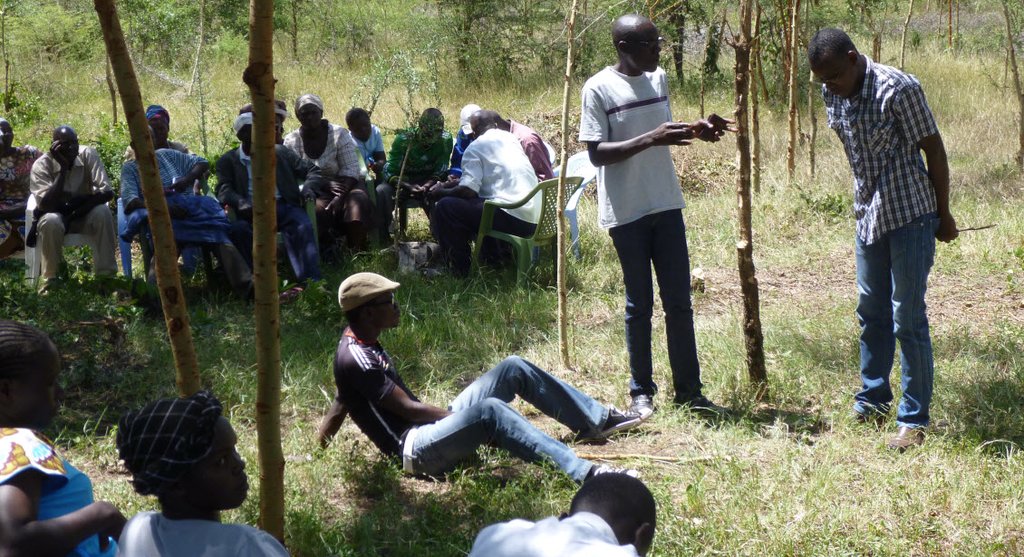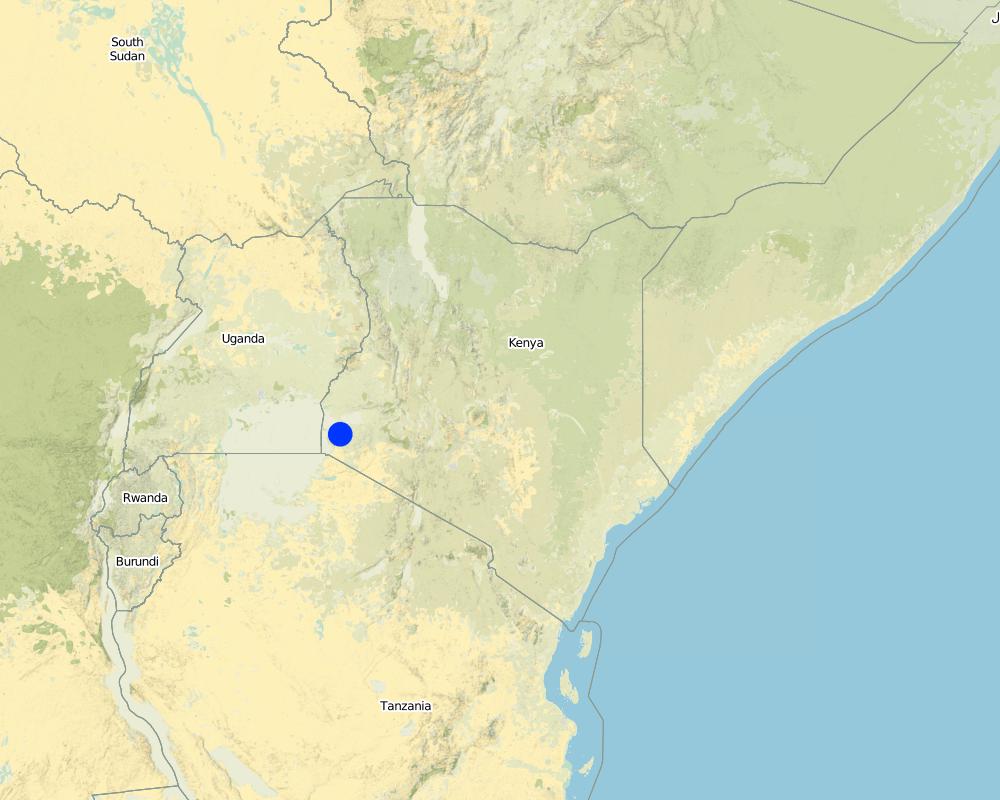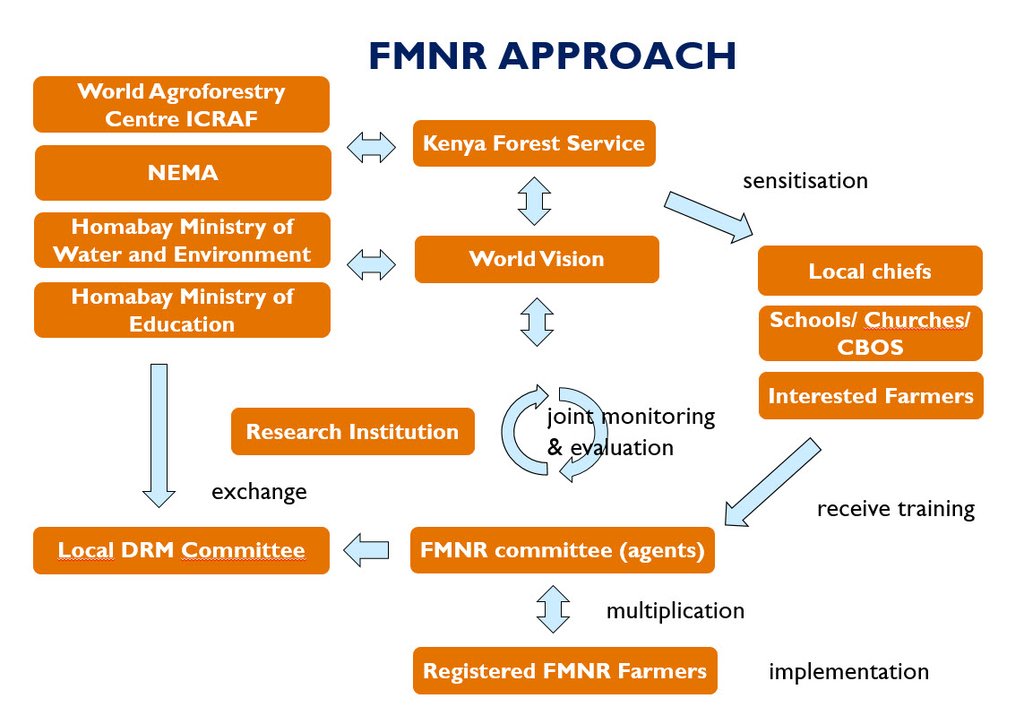FMNR implementation approach [Kenya]
- Création :
- Mise à jour :
- Compilateur : Thomas Kalytta
- Rédacteur : Irene Ojuok
- Examinateurs : Alexandra Gavilano, Deborah Niggli, Hanspeter Liniger, Donia Mühlematter
FMNR nyale
approaches_733 - Kenya
Voir les sections
Développer tout Réduire tout1. Informations générales
1.2 Coordonnées des personnes-ressources et des institutions impliquées dans l'évaluation et la documentation de l'Approche
Personne(s) ressource(s) clé(s)
Spécialiste GDT:
Ojuok Irene
+254725859689
Irene_Ojuok@wvi.org
World Vision
Lambwe Valley ADP Office, Homabay, Kenya
Spécialiste GDT:
Kalytta Thomas
0041445101593
thomas_kalytta@wvi.org
World Vision
Kriesbachstrasse 30, 8600 Dübendorf, Switzerland
Suisse
exploitant des terres:
Sijenyi Onyiego William
0727369635 / 708297048
n/a
Obanda Environmental project Mbita Sub County, Dr Tom Mboya Okeyos Farm along Mbita Homabay Road. The site is by the road side
Nom du projet qui a facilité la documentation/ l'évaluation de l'Approche (si pertinent)
Book project: where people and their land are safer - A Compendium of Good Practices in Disaster Risk Reduction (DRR) (where people and their land are safer)Nom du ou des institutions qui ont facilité la documentation/ l'évaluation de l'Approche (si pertinent)
World Vision (World Vision) - Suisse1.3 Conditions relatives à l'utilisation par WOCAT des données documentées
Quand les données ont-elles été compilées (sur le terrain)?
28/11/2016
Le compilateur et la(les) personne(s) ressource(s) acceptent les conditions relatives à l'utilisation par WOCAT des données documentées:
Oui
1.4 Références au(x) questionnaire(s) sur les Technologies de GDT
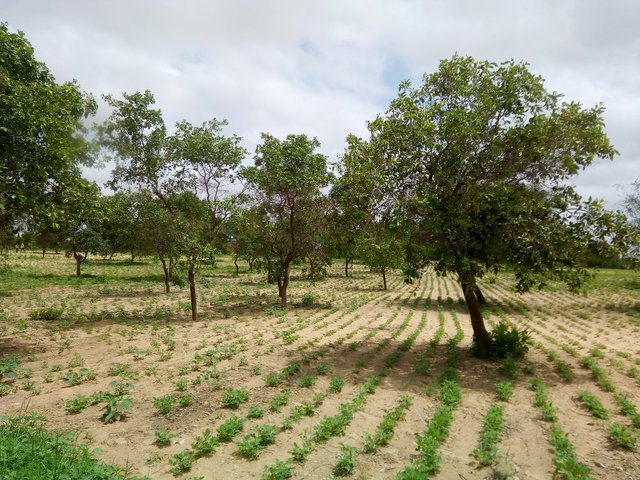
Régénération Naturelle Assistée (RNA) [Sénégal]
None
- Compilateur : Diaminatou SANOGO
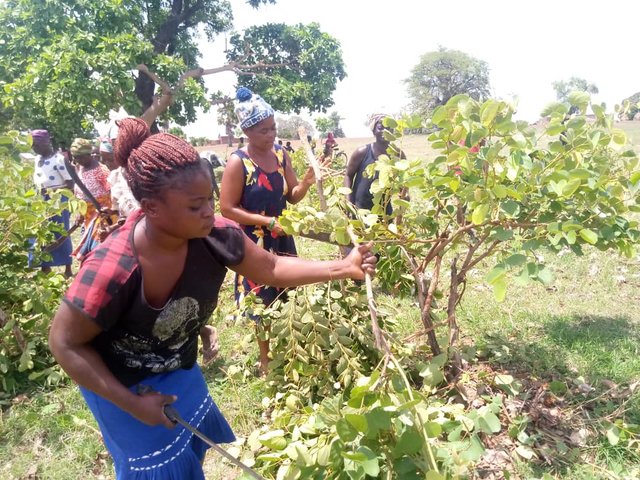
Farmer Managed Natural Regeneration(FMNR) [Ghana]
Farmer Managed Natural Regeneration (FMNR) comprises a set of practices used by farmers to encourage the growth of native trees on agricultural land by systematically allowing regeneration and managing trees and shrubs from tree stumps, roots and seeds.
- Compilateur : Joshua Adombire
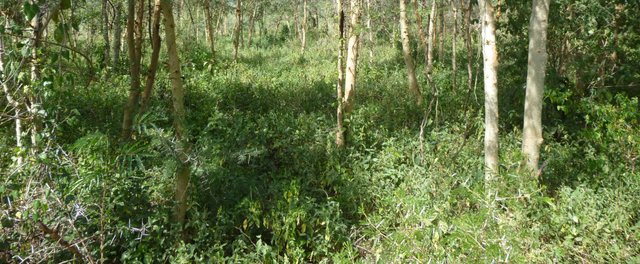
Farmer Managed Natural Regeneration (FMNR) [Kenya]
Farmer Managed Natural Regeneration (FMNR) is a proven SLM Technology to restore degraded wasteland and improve depleted farmland. The farmer regu- lates and facilitates the re-growth of existing trees stumps, or self-sown seeds in the soil, and thus promotes soil fertility and through better ground cover, increases protection from runoff …
- Compilateur : Thomas Kalytta
2. Description de l'Approche de GDT
2.1 Courte description de l'Approche
After consultations with local stakeholders, experts (from NEMA, ICRAF, KFS, Wildlife Kenya) and Homabay County Government representatives the FMNR approach is being introduced by World Vision through a public funded project. The aim of the approach is to promote FMNR and sustainable land and natural resource management through disseminating the basic idea of regenerating trees.
2.2 Description détaillée de l'Approche
Description détaillée de l'Approche:
The approach follows the basic principles of the of Training Trainers ToT (transfer of technology) concept i.e. key stakeholders and agents are trained to pass their knowledge on to others. Through a multi-stakeholder inception workshop all local stakeholders learn about the FMNR technology, its advantages and impacts. Representatives of the county and the national government are invited in order to get their support. Technical experts in agriculture are represented as well.
The Kenya Forest Service (KFS) and World Vision (WV) are the main actors in sensitising the local chiefs, school head teachers, CBOs, self-help groups, farmers' associations and individual farmers about FMNR, Disaster Risk Reduction and other topics. As a result farmers, teachers, schools management committee and CBO members register for the FMNR training, which is also carried out by KFS and WV. Selected farmers (those who are early adopters) are chosen as FMNR agents.
The registered FMNR practitioners (farmers, CBO members, school children, etc.) have to set aside a plot for FMNR application. They implement the technology. Each administrative unit (ward) establishes one FMNR committee under the lead of the local chief. The FMNR committee members (agents) are responsible for further dissemination for training and monitoring of the activities and maintaining the demonstration sites. They also organise exchange visits. They regularly report back to World Vision Development Facilitators. New FMNR farmers register with the committees. Research institutions (e.g. Maseno University) conduct studies to follow-up assumptions and to document change. The Community Disaster Management group is influenced by the FMNR committee and the County administration with regard to erosion control measures and gully restoration.The implementation is jointly monitored by the key stakeholders and documented by World Vision.
2.3 Photos de l'approche
Remarques générales concernant les photos:
Most of the training is done on site which practical demonstrations. 6 fenced demonstration sites and other show cases serve as pilots for the whole community.
2.4 Vidéos de l'Approche
Commentaire, brève description:
A majority of East Africa community relies on agriculture and livestock production as the main source of livelihood yet these sources are experiencing challenges including environmental degradation and climate change. A number of interventions have been promoted at household level. The video teaches about the approach applied in a couple of countries in East Africa.
Date:
09/04/2016
Lieu:
Kenya, Uganda, Tanzania
Nom du vidéaste:
World Vision
Commentaire, brève description:
Video in German language
Im Kampf gegen die Dürre hat Tony Rinaudo eine simple Methode entwickelt. Anstatt Bäume zu pflanzen, greift er zur Schere und stutzt die Pflanzen, die bereits wachsen. Mit sensationellem Erfolg.
The quality is better on youtube: www.youtube.com/watch?v=tgdcbxE-OQo
Date:
02/09/2016
Lieu:
Tanzania
Nom du vidéaste:
World Vision
2.5 Pays/ région/ lieux où l'Approche a été appliquée
Pays:
Kenya
Région/ Etat/ Province:
Hombay County
Autres spécifications du lieu :
Suba and Mbita Sub-Counties
Commentaires:
One major demostration site is indicated only, kindly refer to the FMNR technology for more sites.
Map
×2.6 Dates de début et de fin de l'Approche
Indiquez l'année de démarrage:
2014
Date (année) de fin de l'Approche (si l'Approche n'est plus appliquée):
2017
Commentaires:
The approach of the FMNR technology was introduced by World Vision through a public funded project on climate protection and natural resource management. It received the “Total Kenya Eco Challenge Award” in 2016. The introduction was done through the following steps. The project staff were trained on the concept after which they trained Government staff in forestry, education and agriculture department including chiefs and assistant chief who were to turn out to be the entry point/ ambassadors for the concept. Intense trainings, awareness campaigns, practical demonstrations, consultative meetings and observations were conducted. Till now more than 300 hectares of degraded land was reclaimed through FMNR and over 1000 farmers adopted the practice already.
2.7 Type d'Approche
- fondé sur un projet/ programme
2.8 Principaux objectifs de l'Approche
The main objective of the approach is to promote FMNR and other natural resource management practices including agroforestry, crop diversification, sustainable rural energy sources and rehabilitation of highly degraded areas. It is also to utilise environmental education to advise on disaster risk reduction in order to increase the resilience of the target population against adverse effects of climate change and natural disasters.
2.9 Conditions favorisant ou entravant la mise en œuvre de la(des) Technologie(s) appliquée(s) sous l'Approche
normes et valeurs sociales/ culturelles/ religieuses
- favorise
enabling factors are the medicinal value of trees, herbs, the importance of places for worship and local rituals,
- entrave
livestock and fire put the FMNR sites at risk, fire is sparked on hill tops to attract rain. Some neighbouring farmers also complain about the return of biodiversity especially of monkeys and snakes. Some people still maintain old traditions (clean agriculture) hindering women participating in meetings, from planting trees or working on trees in their homestead. These people are more resistant to new ideas and approaches.
disponibilité/ accès aux ressources et services financiers
- favorise
natural materials can be used (wood, fruits, pods and grass) or sold, money for fire wood can be saved
cadre institutionnel
- favorise
some schools have surplus land which is ideal for FMNR and tree planting,
- entrave
sometimes even members of the school management board send their cows for grazing that hampers the FMNR attempts of the school children
collaboration/ coordination des acteurs
- favorise
most partners are very supportive towards FMNR
cadre juridique (régime foncier, droits d'utilisation des terres et de l'eau)
- entrave
a clear legal framework is lacking, the ownership of "wasteland" needs to be clear otherwise everybody tries to make benefit out of it (over grazing, charcoal burning)
cadre politique
- favorise
the Kenyan Government has issued a policy that 10% of the land should be covered by forest
gouvernance foncière (prise de décisions, mise en œuvre et application des décisions)
- entrave
young farmers complain that they have not the full rights over the family land, so they can only go for FMNR if the fathers agree. As young farmers who have not yet inherited land from their fathers according to customary laws still don’t own land which they could have long term plans. This hinders them from immediate adoption of FMNR due to land ownership rights. Mostly young men are given their share of land at about 40years. Hence this delays in uptake.
connaissances sur la GDT, accès aux supports techniques
- favorise
the Kenyan Forest Service officers were very supportive
marchés (pour acheter les intrants, vendre les produits) et prix
- favorise
access to local markets are an advantage to sell the farm products e.g. honey is on demand, firewood, crop harvest, inputs are not very much needed apart from standard farming tool and strong gloves
charge de travail, disponibilité de la main-d'œuvre
- entrave
FMNR can create more work but the longer-term benefits are obvious. However, lazy people who are not patient will not appear to training sessions because they might not have understood the benefits of the technology.
3. Participation et rôles des parties prenantes impliquées dans l'Approche
3.1 Parties prenantes impliquées dans l'Approche et rôles
- exploitants locaux des terres / communautés locales
small holder farmers, registered FMNR agents, DRR committees
The stakeholders were sensitised, received training, spread the message to peers and take part of the joint monitoring (agents)
- organisations communautaires
CBO and self-help groups, religious leaders (Churches), local NGOs
took part in the training, mobilised their members to adopt the practice, make links to other stakeholders,
- Spécialistes de la GDT/ conseillers agricoles
agricultural extension officers (weak), Kenya Forest Service officers
the KFS officers are involved in the technical training, while the farmers have to go and access the extension officers in the towns to receive their advice
- chercheurs
Maseno University
measure the tree density, the biodiversity change on the demonstration sites
- enseignants/ élèves/ étudiants
teachers and school children
practice FMNR and other innovative technologies
- ONG
SEEK, Nature Kenya, Kenya Scouts
teach the children about environment and nature
- secteur privé
The National Bank in Homabay has been supplying seedlings for tree planting in Homabay County. This was done in collaboration with Kenya Scouts. Now they show also interest in the FMNR technology.
supplied seedlings at the initial stage, show interest in FMNR as well
- gouvernement local
local chiefs
mobilise their communities
- gouvernement national (planificateurs, décideurs)
Homabay County Government
very supportive, links to the different departments, provide match funding, take part in the joint monitoring
- organisation internationale
World Vision, ICRAF,
technical advisor, linkage to donors
3.2 Participation des exploitants locaux des terres/ communautés locales aux différentes phases de l'Approche
| Participation des exploitants locaux des terres/ communautés locales | Spécifiez qui était impliqué et décrivez les activités | |
|---|---|---|
| initiation/ motivation | passive | local farmers, DRR committee members and local chiefs were invited to take part in sensitisation sessions |
| planification | interactive | local chiefs very active in supporting the new technology by motivation local farmers to become registered |
| mise en œuvre | interactive | FMNR committees as technical support, do also monitoring and reporting |
| suivi/ évaluation | interactive | done by FMNR committees, they receive data from all households jointly with other stakeholders and report back to the project management |
| research | soutien extérieur | done by students of the Maseno University by gathering primary data from demonstration sites very 6 months and compiling a biodiversity report |
3.3 Diagramme/ organigramme (si disponible)
Description:
1) Through a multi-stakeholder inception workshop all local stakeholders learn about the FMNR technology, its advantages and impacts.
Representatives of the county and the national government (chiefs) are invited to get their support. Technical experts are represented as well.
2) The Kenya Forest Service and World Vision are the main actors in SENSITISING the local chiefs, school head teachers, CBOs, Self-help Groups, farmer's associations and farmers on the FMNR technology, Disaster Risk Reduction and other topics.
3) As a result farmers, teachers, schools management committee and CBO members register for the FMNR TRAINING, also carried out be KFS and WV.
Selected farmers (early adopters) are chosen as FMNR agents.
4) The registered FMNR practitioners (farmers, CBO members, school children, etc.) have to set aside a plot for FMNR application. They IMPLEMENT the technology.
5) Each administrative unit (ward) establishes one FMNR committee under the lead of the local chief
6) The FMNR committee members (agents) are responsible for further dissemination of the technology, for training and monitoring of the activities and maintaining the demonstration sites. They also organised exchange visits. They report back to World Vision Development Facilitators.
7) New FMNR farmers register with the committees (MULTIPICATION).
8) Research institutions (Maseno University) conduct studies to follow-up assumptions and to document change.
9) The Community Disaster Management group is influenced by the FMNR committee and the County administration in regard to erosion control measures and gully restoration.
10) The implementation is JOINTLY MONITORED by the key stakeholders and documented by World Vision.
11) The Chief officers of the County Government conducts additional monitoring visits.
Auteur:
Thomas Kalytta
3.4 Prises de décision pour la sélection de la Technologie/ des Technologies
Indiquez qui a décidé de la sélection de la Technologie/ des Technologies à mettre en œuvre:
- tous les acteurs concernés dans le cadre d'une approche participative
Expliquez:
The technology is transferred by World Vision from other African contexts. Each land-user is encouraged to try it on a piece of land. Each farmer decides whether he/she adopts it or wait and see how it develops in the neighbourhood. Demonstration plots help show case the impact and power of natural regeneration.
Spécifiez sur quelle base ont été prises les décisions:
- l'évaluation de connaissances bien documentées en matière de GDT (prises de décision fondées sur des preuves tangibles)?
- les résultats de recherches?
4. Soutien technique, renforcement des capacités et gestion des connaissances
4.1 Renforcement des capacités/ formation
Une formation a-t-elle été dispensée aux exploitants des terres/ autres parties prenantes?
Oui
Spécifiez qui a été formé:
- exploitants des terres
- personnels/ conseillers de terrain
Si pertinent, spécifiez le genre, l'âge, le statut, l'ethnie, etc.
there are participants list available but no time to analyse them
Formats de la formation:
- entre agriculteurs (d'exploitants à exploitants)
- zones de démonstration
- réunions publiques
Thèmes abordés:
FMNR, Natural Resource Management, Disaster Risk Reduction, Conservation Agriculture etc.
4.2 Service de conseils
Les exploitants des terres ont-ils accès à un service de conseils?
Oui
Spécifiez si le service de conseils est fourni:
- dans les champs des exploitants?
Décrivez/ commentez:
Done by the FMNR committees and development facilitators from KFS and WV.
4.3 Renforcement des institutions (développement organisationnel)
Des institutions ont elles été mises en place ou renforcées par le biais de l'Approche?
- oui, beaucoup
Spécifiez à quel(s) niveau(x), ces institutions ont été renforcées ou mises en place:
- local
Décrivez l'institution, ses rôles et responsabilités, ses membres, etc.
schools, churches, CBOs.
Précisez le type de soutien:
- renforcement des capacités/ formation
Donnez plus de détails:
same as above
4.4 Suivi et évaluation
Le suivi et l'évaluation font ils partie de l'Approche? :
Oui
Commentaires:
Yes, joint monitoring and evaluation
Si oui, ce document est-il destiné à être utilisé pour le suivi et l'évaluation?
Oui
Commentaires:
perhaps, but separate documents will be created as per donor requirement.
4.5 Recherche
La recherche a-t-elle fait partie intégrante de l’Approche?
Oui
Spécifiez les thèmes:
- écologie
- biodiversity
Donnez plus de détails et indiquez qui a mené ces recherches:
Maseno University, botanic and zoological studies, see separate reports
5. Financement et soutien matériel externe
5.1 Budget annuel de la composante GDT de l'Approche
Indiquez le budget annuel de la composante GDT de l'Approche en $ US:
9230,00
Si le budget annuel précis n'est pas connu, indiquez une fourchette:
- 2 000-10 000
Commentez (par ex. principales sources de financement/ principaux bailleurs de fonds):
The initiative is funded by public donors and co-funded by the county government. For the approach including awareness, campaigns, training and monitoring as well as exposure trips 9230 USD were budgeted per year.
5.2 Soutiens financiers/ matériels fournis aux exploitants des terres
Les exploitants des terres ont-ils reçu un soutien financier/ matériel pour la mise en œuvre de la Technologie/ des Technologies?
Oui
Si oui, spécifiez le(s) type(s) de soutien, les conditions et les fournisseurs:
transport to the demo sites, for local farmers and stakeholders, food during the training, materials for sensitisation, training & monitoring, accommodation only during exposure trips
5.3 Subventions pour des intrants spécifiques (incluant la main d'œuvre)
- aucun
Si la main d'œuvre fournie par les exploitants des terres était un intrant substantiel, elle était:
- volontaire
5.4 Crédits
Des crédits ont-ils été alloués à travers l'Approche pour les activités de GDT?
Non
5.5 Autres incitations ou instruments
D'autres incitations ou instruments ont-ils été utilisés pour promouvoir la mise en œuvre des Technologies de GDT?
Non
6. Analyses d'impact et conclusions
6.1 Impacts de l'Approche
Est-ce que l'Approche a autonomisé les exploitants locaux des terres, amélioré la participation des parties prenantes?
- Non
- Oui, un peu
- Oui, modérément
- Oui, beaucoup
As it connect the different actors and levels.
Est-ce que l'Approche a permis la prise de décisions fondées sur des données probantes?
- Non
- Oui, un peu
- Oui, modérément
- Oui, beaucoup
Evidence can be easily seen by the great replication effect among the land users of the area.
Est-ce que l'Approche a aidé les exploitants des terres à mettre en œuvre et entretenir les Technologies de GDT?
- Non
- Oui, un peu
- Oui, modérément
- Oui, beaucoup
Yes, because the land users have now access to local technical experts (FMNR agents) and demonstration farms.
Est-ce que l'Approche a amélioré la coordination et la mise en œuvre de la GDT selon un bon rapport coût-efficacité?
- Non
- Oui, un peu
- Oui, modérément
- Oui, beaucoup
Yes, greatly, as FMNR committees were established which coordinate the implementation in each ward in a cost effective way.
Est-ce que l'Approche a mobilisé/ amélioré l'accès aux ressources financières pour la mise en œuvre de la GDT?
- Non
- Oui, un peu
- Oui, modérément
- Oui, beaucoup
No, the SLM itself creates sources of income but the approach doesn't mobilise funds only knowledge.
Est-ce que l'Approche a amélioré les connaissances et les capacités des exploitants des terres pour mettre en œuvre la GDT?
- Non
- Oui, un peu
- Oui, modérément
- Oui, beaucoup
Yes, greatly.
Est-ce que l'Approche a amélioré les connaissances et les capacités des autres parties prenantes?
- Non
- Oui, un peu
- Oui, modérément
- Oui, beaucoup
Yes, as it brings all relevant stakeholders together especially during the initiation and monitoring.
Est-ce que l'Approche a construit/ renforcé les institutions, la collaboration entre parties prenantes?
- Non
- Oui, un peu
- Oui, modérément
- Oui, beaucoup
There is quite some exchange and strengthening among the stakeholders. Part of them are local NGOs, CBOs and churches.
Est-ce que l'Approche a atténué les conflits?
- Non
- Oui, un peu
- Oui, modérément
- Oui, beaucoup
Yes, a little, as it brings the local stakeholders together where they can talk and solve conflict e.g. between livestock keepers and farmers.
Est-ce que l'Approche a autonomisé les groupes socialement et économiquement défavorisés?
- Non
- Oui, un peu
- Oui, modérément
- Oui, beaucoup
Yes, a little, as even farmers with very small plots can raise their voices and get ideas how to increase the productivity.
Est-ce que l'Approche a amélioré l'égalité entre hommes et femmes et autonomisé les femmes et les filles?
- Non
- Oui, un peu
- Oui, modérément
- Oui, beaucoup
Women are included in the discussions and training. They get empowered as the households produce fire wood which saves a lot of time for the collection. Some can also sell surplus fire wood. High yield from the farms with trees address food security. Ensuring there is food in a household is always the woman's responsibility.
Est-ce que l'Approche a encouragé les jeunes/ la prochaine génération d'exploitants des terres à s'engager dans la GDT?
- Non
- Oui, un peu
- Oui, modérément
- Oui, beaucoup
Yes, very much. During the discussions the young generation raises their voice and discuss with their fathers how to improve the land-use and productivity.
Est-ce que l'Approche a amélioré les questions foncières et des droits d'utilisation qui entravent la mise en œuvre des Technologies?
- Non
- Oui, un peu
- Oui, modérément
- Oui, beaucoup
Maybe a little, as these issues can be discussed during the gatherings.
Est-ce que l'Approche a conduit à améliorer la sécurité alimentaire et/ou la nutrition?
- Non
- Oui, un peu
- Oui, modérément
- Oui, beaucoup
Since the approach led to the implementation of FMNR and FMNR increases the production and promotes diversification the land-use types.
Est-ce que l'Approche a amélioré l'accès aux marchés?
- Non
- Oui, un peu
- Oui, modérément
- Oui, beaucoup
Est-ce que l'Approche a conduit à améliorer l'accès à l'eau et l'assainissement?
- Non
- Oui, un peu
- Oui, modérément
- Oui, beaucoup
Not the approach but the related technology.
Est-ce que l'Approche a conduit à l'utilisation/ sources d'énergie plus durables?
- Non
- Oui, un peu
- Oui, modérément
- Oui, beaucoup
Not the approach but the related technology. The FMNR campaigns are always integrated with promotions for solar and improved cookstoves and the farmers uptake for clean energy has improved through this. It thus leads to sustainable use of energy indirectly.
Est-ce que l'Approche a amélioré la capacité des exploitants des terres à s'adapter aux changements/ extrêmes climatiques et a atténué les catastrophes liées au climat?
- Non
- Oui, un peu
- Oui, modérément
- Oui, beaucoup
Yes, the approach increases the knowledge of the farmers on Climate change and provides options to adapt better. They now appreciate the indeginous tree species and their value and ability to survive in changing climatic conditions.
Not the approach but the related technology.
6.2 Principale motivation des exploitants des terres pour mettre en œuvre la GDT
- augmenter la production
crop production, e.g. increase from 5 to 8 bags of maize/unit. More wood is obtained from FMNR sites because of biomass increase. Honey production is possible. Fodder production and others.
- augmenter la rentabilité/ bénéfice, rapport coûts-bénéfices
FMNR has provided additional/ alternative sources of income to the beneficiaries. Sale from wood, honey, medicinal components and non-wood products etc. This has led to a diversification of income. The farmer can sell more products and make more profit.
- réduire la dégradation des terres
Areas with deep gullies could be restored through the application of FMNR. There is clear evidence that the technology has a high potential to rehabilitate degraded ecosystems.
- réduire les risques de catastrophe
FMNR also serves to mitigate the impact of annual floods to the crops and settlements. FMNR also improves the micro climate and water availability. That can make an important difference for the yields in years of drought. The trees also act as strong windbreakers thus minimizing disasters related to strong winds like blowing of roofs that is rampant.
- conscience environnementale
FMNR is being discussed and applied on the background of the huge land degradation and deforestation of the area that has seriously affected biodiversity, soil fertility and water availability.
- améliorer les connaissances et compétences en GDT
The approach aims at promoting knowledge and skills on FMNR - an effective SLM technology.
- améliorer l'esthétique
The technology covers barren soil and bleak areas. I can contribute to attract more tourists to the area.
- reduced soil ersosion
Farmers realised that they lost fertile soil in the recent decades due to increasing soil and wind erosion. FMNR protects the soil, improves the micro-climate and nutritious content of the soil.
- grass production for fodder and roofing
In dry spells the farmers lack pastures for their livestock. Grass production is an important coping mechanism to bridge these times. Some types of grass are also needed to cover traditional roofs and huts. Grass production is often promoted on larger school compounds. It can create additional income for school improvements or orphan support if the community respects the rules.
6.3 Durabilité des activités de l'Approche
Les exploitants des terres peuvent-ils poursuivre ce qui a été mis en œuvre par le biais de l'Approche (sans soutien extérieur)?
- oui
Si oui, décrivez de quelle manière:
The local FMNR agents are well known in the community as environmentalists. They have demonstration sites on their farms. They took part in FMNR campaigns and training. Every visitor gets attracted by the technology. The agents introduce them. By applying the new technology their neighbours see and learn about FMNR as well. Even on other occasions in the community e.g funerals, religious meetings, ceremonies, the agents use the opportunity to reach more people with FMNR.
6.4 Points forts/ avantages de l'Approche
| Points forts/ avantages/ possibilités du point de vue de l'exploitant des terres |
|---|
| Sensitisation is integrated in community meetings or gatherings which bring many people together. Some of the meetings are called by local administrators who were the first champions of FMNR so this helps in infusing the knowledge through the sessions. Implementation is mostly by seeing and doing. Many farmers are consciously or subconsciously adopting FMNR as they see the sites in their neighbourhood. As the farmers visit each other alongside other engagements, FMNR monitoring continues since the people like to share new things with their friends and what they have learned. |
| Points forts/ avantages/ possibilités du point de vue du compilateur ou d'une autre personne ressource clé |
|---|
| The ToT approach by working with FMNR agents and a local FMNR committee bridges the gap brought about by the absence of agricultural extension workers - only a few farmers actually visit them in their office in town. Also the day-by-day monitoring is done b y the FMNR committee members and not by the project staff alone. A big advantage is the support of the Kenya Forest Service officers. They were ready to help with the on-site training. Crucial for the success of any approach is to involve and win over the local chiefs. They really have understood the benefits and even try to apply the technology themselves. |
6.5 Faiblesses/ inconvénients de l'Approche et moyens de les surmonter
| Faiblesses/ inconvénients/ risques du point de vue de l’exploitant des terres | Comment peuvent-ils être surmontés? |
|---|---|
| Lazy people who are not patient will not appear to training sessions because they might not have understood the benefits of the technology. | Continuous engagements and ensuring the sites are at strategic places where all farmer can see them easily. These people can be convinced through the success of others. |
| The approach seeks the support of all levels (County and local government, CBOs, local farmers, schools etc.) so it is quite time consuming and requires skilled personal as facilitators. | A donor needs to take this into account in terms of available budget and life time of the project. |
| Faiblesses/ inconvénients/ risques du point de vue du compilateur ou d'une autre personne ressource clé | Comment peuvent-ils être surmontés? |
|---|---|
| Some people still maintain old traditions (clean agriculture) hindering women participating in meetings, from planting trees or working on trees in their homestead. These people are more resistent to new ideas and approaches. | The tradition is being demystified especially with the church leaders and with more exposure. This might change their thinking. |
7. Références et liens
7.1 Méthodes/ sources d'information
- visites de terrain, enquêtes sur le terrain
3 field visits
- interviews/entretiens avec les exploitants des terres
2 interview
- interviews/ entretiens avec les spécialistes/ experts de GDT
3 Skype calls
- compilation à partir de rapports et d'autres documents existants
4 reports
7.2 Références des publications disponibles
Titre, auteur, année, ISBN:
Farmer-Managed Natural Regeneration Enhances Rural Livelihoods in Dryland West Africa, Weston, Peter, Reaksmey Hong, Carolyn Kaboré & Christian A. Kull, Environmental Management Volume 55, Issue 6, pp 1402–1417,2015, ISBN 0364-152X00267-015-0469-1
Disponible à partir d'où? Coût?
Springer, USD 35
Titre, auteur, année, ISBN:
Re-greening the Sahel: farmer-led innovation in Burkina Faso and Niger, Reij, C.; Tappan, G.; Smale, M., in Millions fed : proven successes in agricultural development, 2009, ISBN 9780896296619
Disponible à partir d'où? Coût?
International Food Policy Research Institute
7.3 Liens vers les informations pertinentes disponibles en ligne
Titre/ description:
Farmer Managed Natural Regeneration Hub
URL:
http://fmnrhub.com.au/
Titre/ description:
Der Waldmacher. Der Agrarexperte Tony Rinaudo verwandelt abgeholzte Steppen in grüne Wälder. Seine Methode könnte für Afrika bedeutender werden als Milliarden von Dollar Entwicklungshilfe.
URL:
http://www.tagesanzeiger.ch/wissen/natur/der-waldmacher/story/26739960
Liens et modules
Développer tout Réduire toutLiens

Régénération Naturelle Assistée (RNA) [Sénégal]
None
- Compilateur : Diaminatou SANOGO

Farmer Managed Natural Regeneration(FMNR) [Ghana]
Farmer Managed Natural Regeneration (FMNR) comprises a set of practices used by farmers to encourage the growth of native trees on agricultural land by systematically allowing regeneration and managing trees and shrubs from tree stumps, roots and seeds.
- Compilateur : Joshua Adombire

Farmer Managed Natural Regeneration (FMNR) [Kenya]
Farmer Managed Natural Regeneration (FMNR) is a proven SLM Technology to restore degraded wasteland and improve depleted farmland. The farmer regu- lates and facilitates the re-growth of existing trees stumps, or self-sown seeds in the soil, and thus promotes soil fertility and through better ground cover, increases protection from runoff …
- Compilateur : Thomas Kalytta
Modules
Aucun module trouvé


